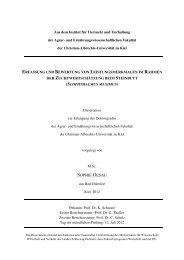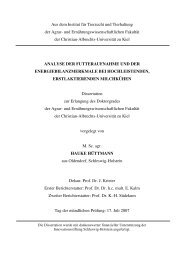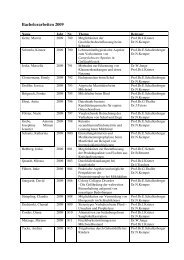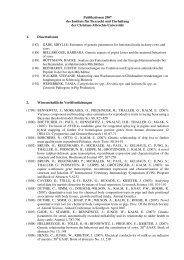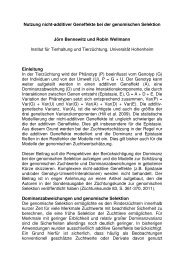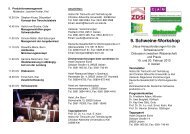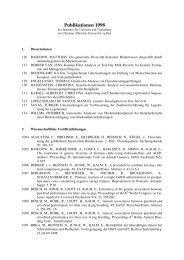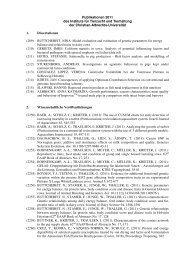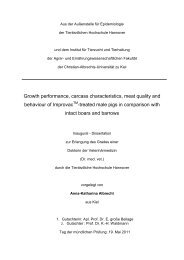Verena Gonzalez Lopez, 2011 - Institut für Tierzucht und Tierhaltung ...
Verena Gonzalez Lopez, 2011 - Institut für Tierzucht und Tierhaltung ...
Verena Gonzalez Lopez, 2011 - Institut für Tierzucht und Tierhaltung ...
Sie wollen auch ein ePaper? Erhöhen Sie die Reichweite Ihrer Titel.
YUMPU macht aus Druck-PDFs automatisch weboptimierte ePaper, die Google liebt.
Introduction<br />
In Germany, the Piétrain pig is bred by independent herdbook breeding organizations<br />
in which small numbers of specialized breeders are organized. Since 1980, the<br />
number of Piétrain herdbook sows in Schleswig-Holstein (SH) decreased from 1,160<br />
to 446 in 2009 (LWK SH, 2010). Such a small population is at risk because an<br />
increase of inbreeding is expected with detrimental effects, such as inbreeding<br />
depression, occurrence of genetic defects and loss of usable genetic variability for<br />
genetic improvement (Falconer and Mackay, 1996). <strong>Gonzalez</strong> <strong>Lopez</strong> et al. (<strong>2011</strong>)<br />
reported a continuously decreasing effective population size that resulted from<br />
increasing inbreeding rates. In view of these developments a common breeding<br />
evaluation system was implemented for the Piétrain populations in SH and Baden-<br />
Württemberg (BW) in 2009 and boars from BW with comparable estimated breeding<br />
values (EBV) are now also available to the herdbook breeders in SH. The Piétrain<br />
herdbook organization in Schleswig-Holstein (SHZ) has expressed interest in an<br />
application of dynamic optimization tool to allow the management of inbreeding with<br />
additional potential for increasing genetic gain. In practice, selective breeding<br />
programs may be considered as a two stage process. In the first instance, animals<br />
are selected according to specific criteria and used as parents, a process that also<br />
determines the genetic contribution of each parent to the next generation. In this<br />
context, several authors have suggested different dynamic tools to maximize genetic<br />
progress of selected animals while constraining the inbreeding rate at a predefined<br />
value (Meuwissen, 1997; Gr<strong>und</strong>y et al., 1998; Meuwissen <strong>und</strong> Sonesson, 1998;<br />
Gr<strong>und</strong>y, 2000). These methods optimize the number of selected animals and their<br />
contributions to the next generation. Simulation studies showed that such<br />
approaches could generate genetic gains more than 20% higher compared to<br />
traditional selection based on BLUP EBV at the same rate of inbreeding (Meuwissen,<br />
1997). After selecting parents for the next generation, the following step is to<br />
establish a proper mating policy. Several mating systems, such as minimum<br />
coancestry, compensatory and minimum variance mating, generate less inbreeding<br />
while producing at least as much genetic gain as random mating in breeding<br />
schemes where the parents are truncation selected (Caballero et al., 1996). The<br />
mating system that is generally recommended is minimum coancestry mating<br />
(Caballero et al., 1996; Sonesson and Meuwissen 2000; Meuwissen 2007).<br />
39



